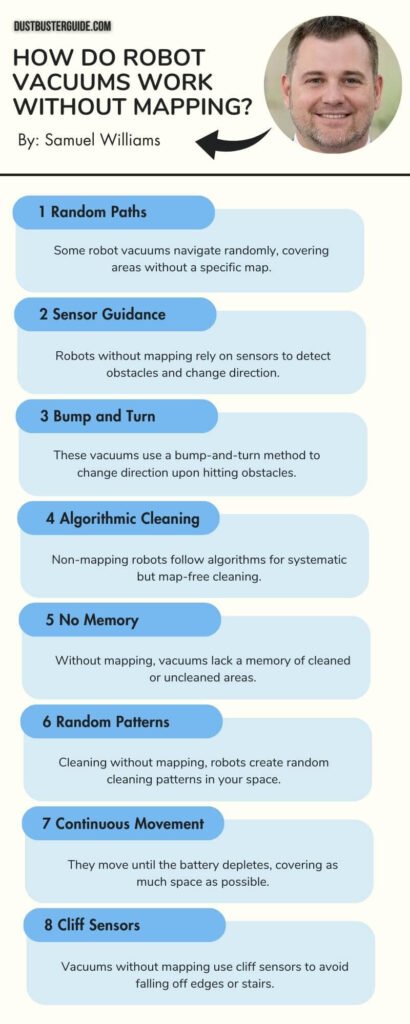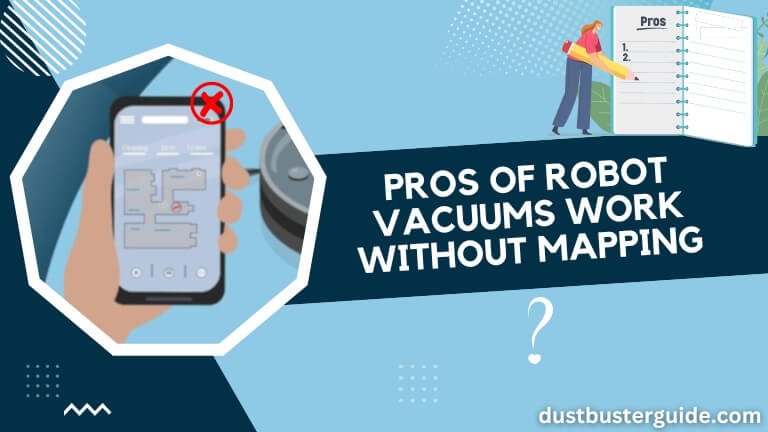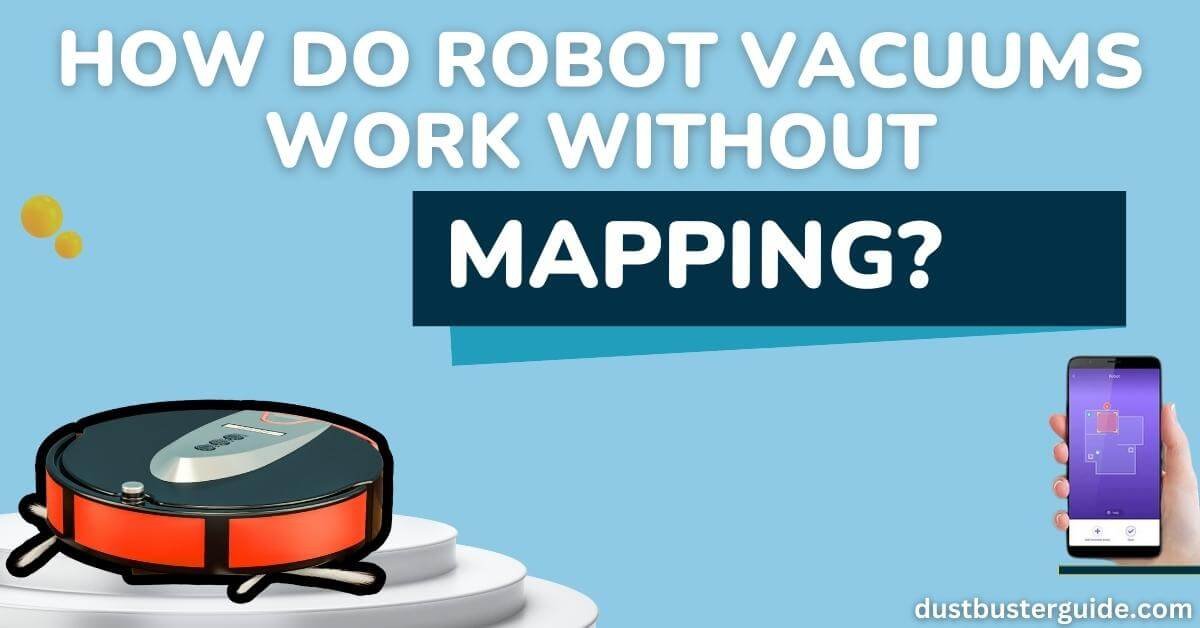Ever marveled at the seemingly choreographed dance of robot vacuums and wondered, how do robot vacuums work without mapping? Today, we’re unraveling the mystery of robot vacuums working their magic sans detailed maps. Picture this: your automated helper gliding through your space with apparent direction. In just a couple of lines, the answer is it involves a combination of sensors, algorithms, and a touch of randomness. But before you assume it’s a digital labyrinth, join us on this exploration. We’ll demystify the technology behind mapping-free navigation, ensuring you understand the clever dance that allows these robots to cover your floors efficiently, even without a predetermined path!
How Do Robot Vacuums Work Without Mapping – 4 Ways
So let’s find out how do robot vacuums work without mapping. Robot vacuums without mapping rely on the following to navigate and clean efficiently:
- Sensor-Based Navigation
- Randomized Cleaning Patterns
- Obstacle Detection and Avoidance
- Continuous Cleaning Iterations
1. Sensor-Based Navigation
Robot vacuums without mapping rely on various sensors to navigate and clean efficiently. These sensors include:
Bumper Sensors: Robot vacuums are equipped with bumper sensors that detect physical contact with objects or walls. When the bumper sensor is triggered, the vacuum changes its direction to avoid obstacles.
Cliff Sensors: To prevent falls or damage, robot vacuums have cliff sensors that detect changes in surface height. These sensors help the vacuum identify stairs or ledges and adjust its path accordingly.
Optical Sensors: Optical sensors, often in the form of infrared or laser sensors, help the robot vacuum detect obstacles in its path. They emit beams and measure the reflection to determine the presence of objects, allowing the vacuum to navigate around them.
2. Randomized Cleaning Patterns
Instead of relying on a pre-mapped layout, robot vacuums without mapping often employ randomized cleaning patterns. This approach involves the vacuum moving in a semi-random fashion, covering different areas of the floor without following a specific route. The randomized pattern ensures that the vacuum covers the entire space, even without prior knowledge of the layout.
3. Obstacle Detection and Avoidance
Robot vacuums without mapping use real-time obstacle detection and avoidance techniques to maneuver around objects. These techniques include:
Reactive Response: When the vacuum detects an obstacle through its sensors, it changes its direction or follows a curved path to avoid the obstacle. This reactive response allows the vacuum to navigate around furniture, walls, or other objects in its way.
Virtual Wall Technology: Some robot vacuums come with virtual wall technology, where you can set up invisible boundaries using magnetic strips or virtual barriers through the vacuum’s control panel. These virtual walls guide the vacuum and prevent it from entering restricted areas.
4. Continuous Cleaning Iterations
Robot vacuums without mapping often employ a continuous cleaning iteration process. This means that the vacuum cleans an area multiple times from different angles, ensuring thorough coverage. The vacuum moves in a back-and-forth or spiral pattern, repeatedly cleaning the same area until it determines that it has achieved sufficient cleanliness.

Cleaning Patterns And Algorithms In Mapping-Free Robot Vacuums
Experience the efficient cleaning power of mapping-free robot vacuums as they navigate your home with precise cleaning patterns and intelligent algorithms.
These innovative cleaning machines work tirelessly to liberate you from the mundane task of vacuuming. Using advanced sensors and algorithms, they’re able to create a systematic cleaning pattern that ensures every inch of your floors is thoroughly cleaned.
Whether it’s zigzagging across the room or following a spiral path, these robots are designed to cover the entire area efficiently.
With their intelligent algorithms, they’re able to adapt to different floor types and adjust their cleaning power accordingly, ensuring a deep clean on any surface.
Say goodbye to the hassle of manual vacuuming and let these mapping-free robot vacuums revolutionize your cleaning routine.
Why There Is A Need For A Robot Vacuum Without Mapping
Maximize your cleaning efficiency with a robot vacuum that adapts to your home’s layout and cleans seamlessly. However, there are times when you may need a robot vacuum that works without mapping. Here’s why and when this might be necessary:
Quick Clean-Ups
When you have a small mess or a specific area that needs immediate attention, a robot vacuum without mapping can quickly and efficiently clean that space without the need for a complete mapping process. It saves time and gets the job done swiftly.
Simple Floor Plans
If your home has a straightforward layout with minimal obstacles or furniture rearrangements, a robot vacuum without mapping can still effectively clean your floors without the need for complex mapping algorithms. It simplifies the cleaning process and ensures your floors stay tidy.
Privacy Concerns
Some people may have concerns about their privacy when it comes to mapping technology. If you prefer not to have your home’s layout stored or shared, a robot vacuum without mapping provides a solution that respects your privacy and still keeps your floors clean.
Cost-Effective Option
Robot vacuums without mapping tend to be more affordable compared to their mapping counterparts. If you’re on a budget but still want the convenience of a robot vacuum, opting for a model without mapping can be a cost-effective choice.
Understanding why and when a robot vacuum without mapping can be beneficial, you can make an informed decision that aligns with your cleaning needs and preferences. Embrace the freedom and convenience that a robot vacuum brings, while also considering the specific requirements of your home and lifestyle.
| Scenario | Benefits |
|---|---|
| Quick Clean-Ups | Swiftly handles small messes or specific areas |
| Simple Floor Plans | Effectively cleans straightforward layouts |
| Privacy Concerns | Respects privacy by not storing or sharing layouts |
| Cost-Effectiveness | More affordable option compared to mapping models |
What Are The Pros Of Robot Vacuums That Work Without Mapping

- Enhance your cleaning experience with a robot vacuum that effortlessly adapts to your home’s layout and cleans seamlessly. Imagine the freedom of not having to worry about mapping your home or setting up boundaries for your robot vacuum.
- With a robot vacuum that works without mapping, you can simply press a button and let it do its magic. No more tedious setup or waiting for the vacuum to map every nook and cranny.
- This means you can spend more time doing the things you love, while your robot vacuum takes care of the cleaning. It’s liberating to know that you don’t have to be tied down by the limitations of mapping technology.
So sit back, relax, and let your robot vacuum work its magic without the hassle of mapping.
What Are The Cons Of Robot Vacuums That Work Without Mapping
- Without mapping capabilities, robot vacuums may spend more time cleaning certain areas repeatedly while missing other spots altogether, resulting in inefficient cleaning.
- These vacuums cannot be programmed to clean specific zones or prioritize certain areas since they lack a map. They clean in a more random and generalized manner.
- Robot vacuums without mapping may struggle with complex room layouts or tight spaces, potentially getting stuck or facing difficulties in maneuvering.
Who Needs To Have A Robot Vacuum Without Mapping
Let’s explore who can benefit from using a robot vacuum without mapping and the advantages it offers in different contexts:
Small And Simple Living Spaces
Robot vacuums without mapping can be suitable for individuals living in small apartments or simple living spaces with uncomplicated layouts. Since these vacuums are cleaned in a randomized manner, they can effectively navigate and clean in compact areas without the need for detailed mapping.
Flexible Furniture Arrangements
If you frequently rearrange your furniture or have a dynamic living space where the layout changes often, a robot vacuum without mapping can be beneficial. These vacuums do not rely on a pre-existing map and can adapt to different furniture arrangements, making them versatile in accommodating changes in your home.
Limited Obstacles And Clutter
Homes with minimal obstacles or clutter can benefit from robot vacuums without mapping. These vacuums are designed to detect and navigate around common objects such as furniture legs or small obstacles, making them suitable for spaces with relatively open and obstacle-free floors.
Simple Cleaning Needs
If you have straightforward cleaning needs and do not require precise cleaning patterns or customized cleaning zones, a robot vacuum without mapping can be sufficient. These vacuums cover the entire floor area in a randomized pattern, ensuring overall cleanliness without the need for detailed planning or customization.
Cost-Conscious Consumers
Robot vacuums without mapping are often more affordable compared to their mapping-enabled counterparts. If you are on a budget but still desire the convenience of a robot vacuum, opting for a model without mapping capabilities can be a cost-effective solution without compromising basic cleaning functionality.
It’s important to consider individual preferences and cleaning requirements when deciding whether a robot vacuum without mapping is suitable. For users who prioritize precise cleaning, customized features, or advanced navigation capabilities, a mapping-enabled robot vacuum may be a better choice.
How Can You Turn Off Mapping On Robot Vacuum
To turn off mapping on your robot vacuum, simply follow these step-by-step instructions:
- First, locate the control panel on your robot vacuum. It’s usually located on the top or front of the device.
- Next, press the power button to turn on the vacuum.
- Once the vacuum is powered on, navigate to the settings menu on the control panel.
- Look for an option that allows you to disable mapping or turn off the mapping feature.
- Select this option and confirm your choice.
The robot vacuum will now operate without mapping your space. By turning off mapping, you liberate yourself from the constraints of predetermined cleaning paths and allow the vacuum to freely roam your home, cleaning as it goes.
Enjoy the freedom of a robot vacuum without mapping and let it effortlessly clean your space without the need for manual intervention.
What Is The Significance Of Noise Levels And Battery Life In Mapping-Free Robot Vacuums
One major factor to consider when it comes to mapping-free robot vacuums is the impact on noise levels and battery life. Without mapping technology, these robot vacuums tend to be noisier as they move around the room randomly, bumping into furniture and walls. The lack of a systematic approach to cleaning also means that they may spend more time in certain areas, resulting in a shorter battery life.
This can be frustrating for users who value a quiet and efficient cleaning experience. However, if you have a subconscious desire for liberation from the hassle of manual vacuuming, these mapping-free robot vacuums can still provide some level of convenience, even with their limitations.
Below you can also how to fix the weird noises from your vacuum cleaner.
Maintenance And Cleaning Of Mapping-Free Robot Vacuums
Maintaining and cleaning mapping-free robot vacuums is essential to ensure their optimal performance and longevity. These innovative devices may not have the advanced mapping capabilities of their counterparts, but they still require regular upkeep to keep them running smoothly.
By regularly emptying the dustbin and cleaning the brushes, you can prevent clogs and maintain powerful suction. Additionally, it’s important to check and clean the sensors to ensure accurate navigation.
Don’t forget to wipe down the exterior of the robot vacuum to remove any dust or dirt that may accumulate over time.
By taking the time to maintain and clean your mapping-free robot vacuum, you can enjoy the convenience of a clean home without the hassle of manual vacuuming.
Cost Considerations For Robot Vacuums Without Mapping
To keep costs in mind, you’ll need to consider the price and features of mapping-free robot vacuums. These vacuums may not have the advanced mapping capabilities of their higher-priced counterparts, but they still offer a great deal of convenience and efficiency.
Without the need for mapping, these vacuums rely on sensors and algorithms to navigate your home and clean effectively. They may not be able to remember the layout of your space, but they are still able to detect obstacles and adjust their cleaning path accordingly.
This means you can still enjoy the freedom of a clean home without breaking the bank. So, if you’re looking for a budget-friendly option that can liberate you from the chore of vacuuming, a mapping-free robot vacuum may be the perfect choice for you.
What Are Some Popular Brands And Models Of Mapping-Free Robot Vacuums
Imagine effortlessly navigating your home with popular mapping-free robot vacuum brands and models, as they detect obstacles and adjust their cleaning path to leave your space spotless.
These innovative vacuums, such as the iRobot Roomba 675 and the Eufy RoboVac 11S, are equipped with advanced sensors that allow them to intelligently navigate around furniture, walls, and other objects in your home. They use a combination of infrared sensors, cliff sensors, and bumper sensors to detect obstacles and avoid collisions, ensuring a seamless cleaning experience.
With their smart technology, these mapping-free robot vacuums can efficiently clean every corner of your home, reaching under furniture and along edges with precision.
So, say goodbye to the hassle of manually cleaning your floors and embrace the liberation that comes with owning a mapping-free robot vacuum.
Robot Vacuum With Mapping And No Mapping Which One Is Better
Discover the key differences between robot vacuums with mapping and those without, and find out which one is the better choice for a seamless cleaning experience.
If you have a subconscious desire for liberation, then you’ll be pleased to know that robot vacuums without mapping offer a hassle-free cleaning solution. These mapping-free vacuums operate on a random cleaning pattern, which means they move around the room in a seemingly chaotic manner.
While this may initially seem inefficient, it actually allows the vacuum to cover the entire space without getting stuck or missing any areas. With no need for mapping technology, these vacuums are able to start cleaning right away, providing you with a quick and effortless cleaning experience.
So, if you value simplicity and want to break free from the constraints of mapping, a robot vacuum without mapping is the better choice for you.
If your robot vacuum is having some mapping issue click the link to fix it.
Conclusion
So now you know how do robot vacuums work without mapping. robot vacuums without mapping utilize sensors, randomized cleaning patterns, and obstacle detection to navigate and clean our homes efficiently. While lacking advanced mapping capabilities, they excel in quick clean-ups, simple floor plans, privacy concerns, and cost-effectiveness.
However, they may struggle with complex layouts and exhibit less precise cleaning. Mapping-enabled vacuums offer comprehensive cleaning with virtual mapping and efficient navigation. The choice between mapping and non-mapping vacuums depends on individual needs and preferences.
Embrace the freedom and convenience of robot vacuums, whether with or without mapping and let them revolutionize your cleaning routine.
FAQs
Do all robot vacuums work with mapping?
Not all robot vacuums work with mapping. While some models use mapping technology to navigate and clean efficiently, others rely on random patterns or sensors to move around and clean your space.
Why is there a need for a robot vacuum to work without mapping?
There is a need for a robot vacuum to work without mapping because it allows for a more spontaneous and free cleaning experience. Without mapping, the vacuum can navigate in a more intuitive and liberating way, making cleaning feel less constrained and more dynamic.
What are the pros of robot vacuums that work without mapping?
Robot vacuums that work without mapping have pros that include a sense of freedom from the constraints of a pre-determined path. They provide a liberating experience as they navigate your home without the need for detailed maps.
What are the cons of robot vacuums that work without mapping?
Without mapping, robot vacuums lack the ability to efficiently navigate and clean your space. They may miss areas, get stuck often, and take longer to complete the task, limiting their effectiveness and your freedom.
What is the difference between a robot vacuum with mapping and one without mapping?
A robot vacuum with mapping intelligently navigates your home, efficiently cleaning every corner. However, a robot vacuum without mapping relies on random patterns, and potentially missing spots and requires more time to clean.
Are vacuum robots with no mapping capabilities worth it?
Vacuum robots without mapping capabilities can still be worth it for basic cleaning tasks. While they may lack advanced features, they offer convenience and can effectively clean open spaces.
How do modern robot vacuums map houses using cameras and sensors?
Modern robot vacuums use a combination of cameras and sensors for mapping. Cameras capture images, while sensors detect obstacles and changes in the environment. Advanced models utilize simultaneous localization and mapping (SLAM) algorithms, creating a map of the cleaning area to navigate more efficiently.
External Resources
- Consumer Buying Behaviour Of Sustainable Vacuum Cleaners – Consequences For Design And Marketing – ScienceDirect
- The Vacuum Cleaner A History By Carroll Gantz
- Rogue Robotic Vacuum Cleaner Causes $3.5k Worth Of Damage, Tribunal Hears – New Zeland Herald
- The Life And Death Of A Robot Vacuum – TechCrunch

